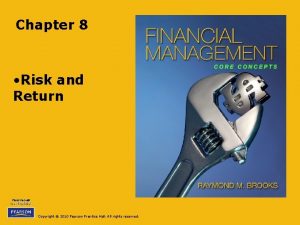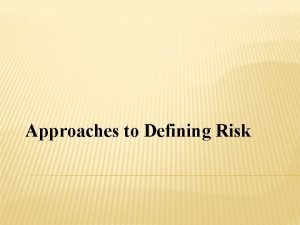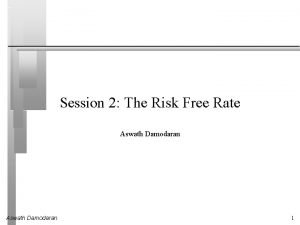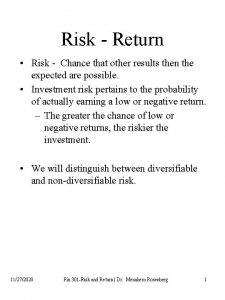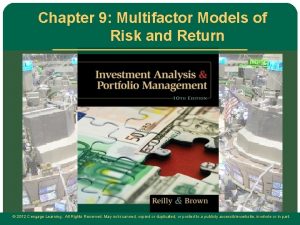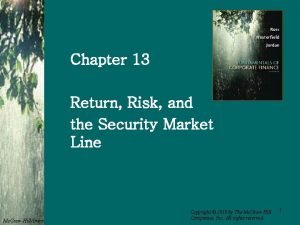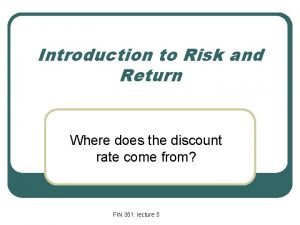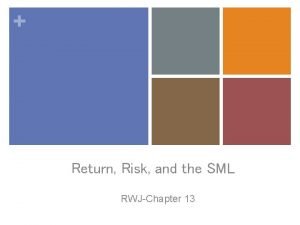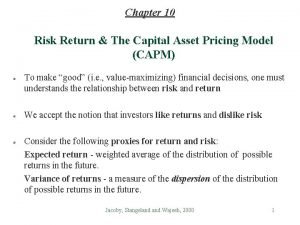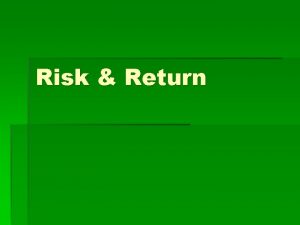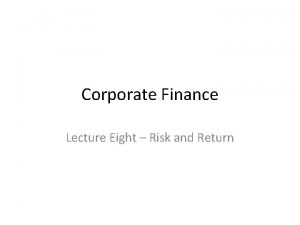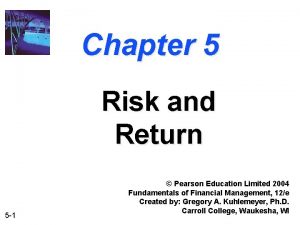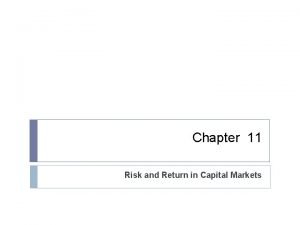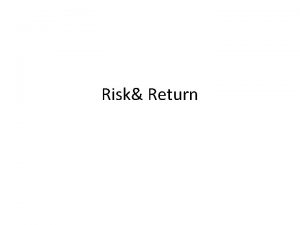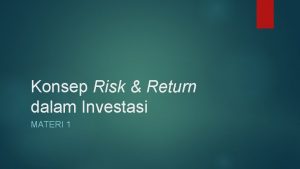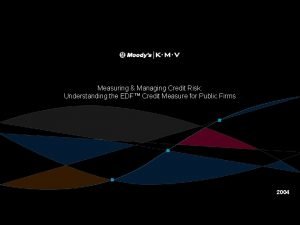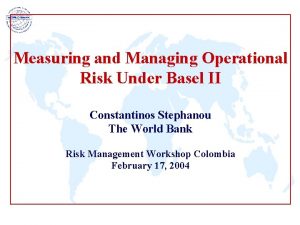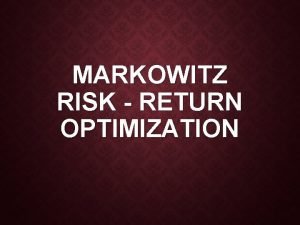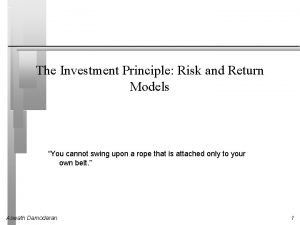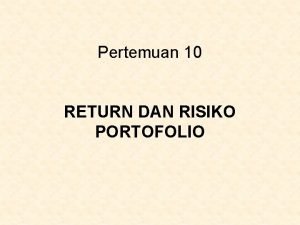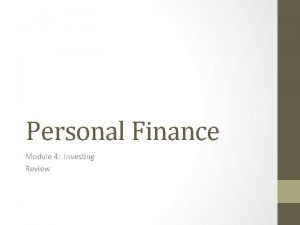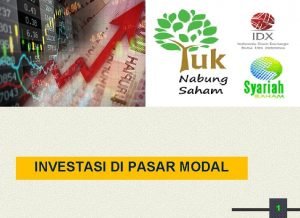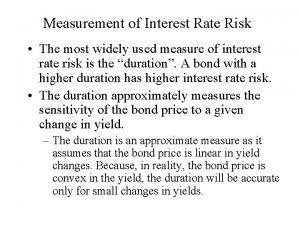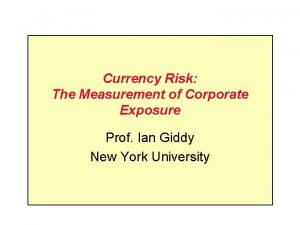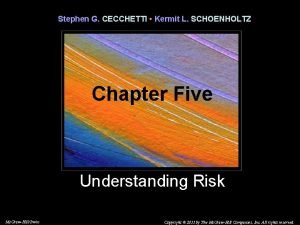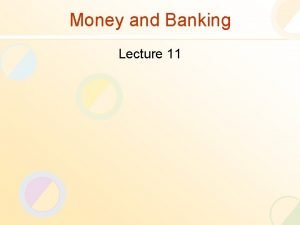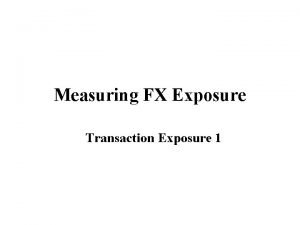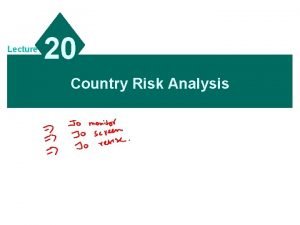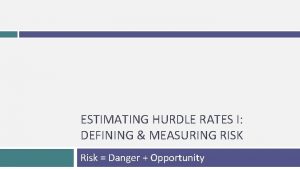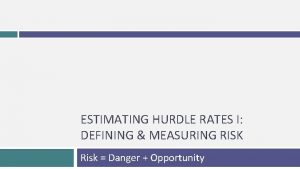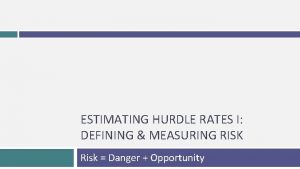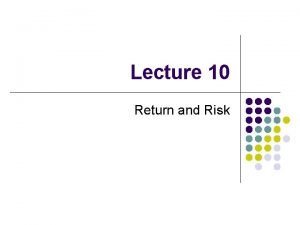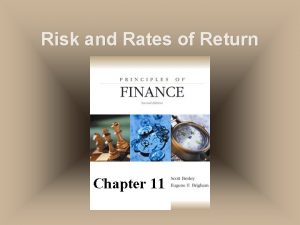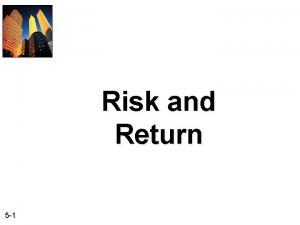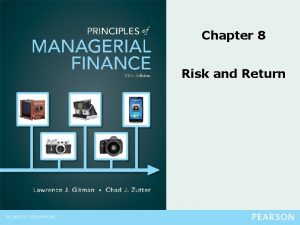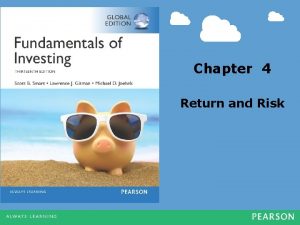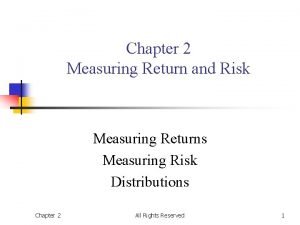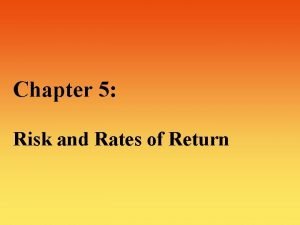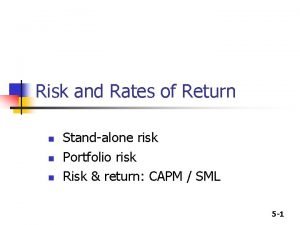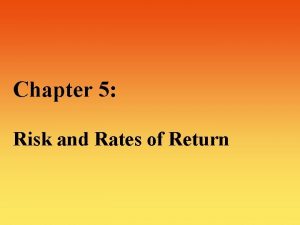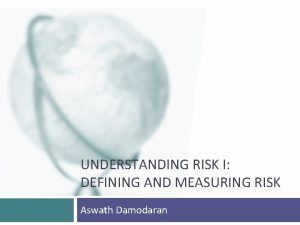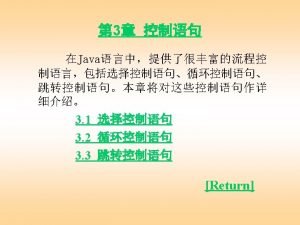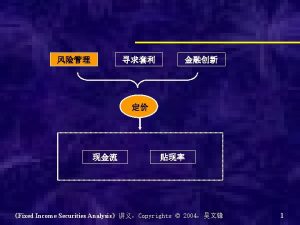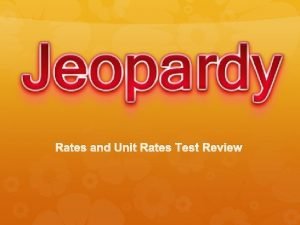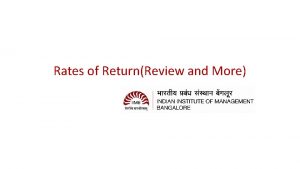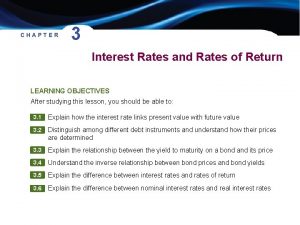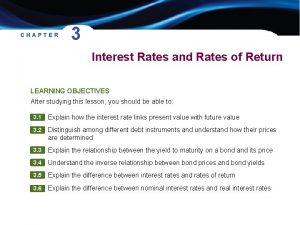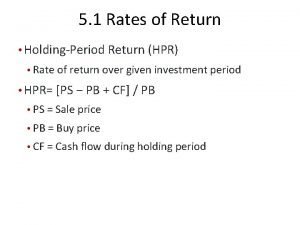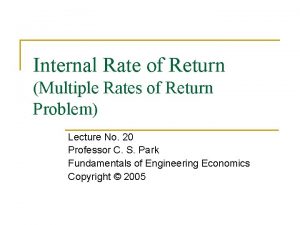Risk and Rates of Return Defining and Measuring













































- Slides: 45

Risk and Rates of Return

Defining and Measuring Risk n What is risk in the financial world n n n What are some examples of risky investments? n n n What security is usually considered to be a risk free investment?

Probability Distributions n Definition: A probability distribution is a listing of all possible outcomes with a probability assigned to each. The probabilities must sum to 1. 00 (i. e. , 100%).

Probability Distributions - cont n Which do you think is more risky? n Why?

• Expected Rate of Return n The following all mean the same thing ¨ The rate of return expected to be realized from an investment. ¨ The mean value of the probability distribution of possible returns. ¨ The weighted average of the outcomes, where the weights are the probabilities. ¨

Expected Rate of Return - cont

Continuous vs Discrete Probability Distributions n Discrete Probability Distribution: ¨ The number of outcomes is limited (ie finite)

Continuous vs Discrete Probability Distributions cont n Continuous Probability Distribution: ¨ The number of outcomes is unlimited (ie infinite)

Measuring Stand Alone Risk: The Standard Deviation

Measuring Stand Alone Risk: The Standard Deviation

Measuring Stand Alone Risk: The Standard Deviation


Measuring Risk Coefficient of Variation n Standardized measure of risk per unit of return Calculated as the standard deviation divided by the expected return Useful where investments differ in risk and expected returns

Measuring Risk - Coefficient of Variation (cont) n Implications: ¨ ¨

Risk Aversion and Required Returns n Risk-Aversion: ¨ Most investors don’t like risk. In, other words, they’re averse to it. ¨ Risk-averse investors require higher expected rates of return for higher-risk securities. ¨ Exceptions:

Risk Aversion and Required Returns n Risk Premium: ¨ The portion of the expected return on an investment that can be attributed to its additional risk ¨ The difference between the expected return of a given risky asset and that of a less risky asset (e. g. , a risk-free asset such as a T-bill): Example: You can invest $1 million in a one-year T-bill at 5% or in Biobotics stock. What’s the risk premium on Biobotics?

Portfolio Risk – Holding Combinations of Assets n Portfolio - a collection of investment securities n Portfolio Returns -The expected return on a portfolio ( k^ p ) is the weighted average return of the stocks held in the portfolio. (Note: The sum of the wi’s has to add up to 1. 00, or 100%. )

Portfolio Returns n Example: What is the expected return of a portfolio made up of: 25% Martin Products, 45% U. S. Electric, and 30% Biobotics?

Portfolio Returns - Cont How is an expected portfolio return different from a realized portfolio return? ¨ The realized rate of return is the return that is actually earned! ¨ The realized return is usually different from the expected return!

Return Distribution for two perfectly negatively correlated stocks

Return Distribution for two perfectly positively correlated stocks

Portfolio Risk n Correlation Coefficient ( r ): ¨ A measure of the degree of relationship between 2 variables, such as the expected return of company A and the expected return of company B. ¨ Positively correlated stocks’ rates of return tend to move in the same direction. ¨ Negatively correlated stocks’ rates of return tend to move in opposite directions. ¨ Perfectly correlated stocks’ rates of return move exactly together or exactly opposite.

Portfolio Risk - cont n Risk Reduction: ¨ Combining stocks that are NOT perfectly correlated will reduce portfolio risk. ¨ We call this diversification. ¨ The risk of a portfolio is reduced as the number of stocks in the portfolio increases. ¨ The lower the positive correlation of each stock we add to the portfolio, the lower the risk.


Effects of Portfolio Size on Portfolio Risk for Average Stocks

Firm Specific vs Market Risk n Firm-Specific Risk: - That part of a security’s risk associated with factors generated by events, or behaviors, specific to the firm. ¨ Examples of such firm-specific factors: n n n n It can be eliminated by proper diversification. What do we mean by “proper”?

Firm Specific vs Market Risk (cont) n Market Risk: - That part of a security’s risk that cannot be eliminated by diversification because it is associated with economic or market factors that systematically affect most firms. ¨ Examples n n n of such factors:

Firm Specific vs Market Risk (cont) n Investors who hold a company’s stock as part of a diversified portfolio will be willing to pay more for that stock than someone how holds only that one stock. ¨ n n n Why? Therefore, we say a stock’s relevant risk is that part of the stock’s risk that cannot be diversified away… i. e. , its market risk. This risk reflects the stock’s contribution to a diversified portfolio. How can we measure this relevant risk?

The Concept of Beta n Beta Coefficient ( ): ¨A measure of the extent to which the returns on a given stock move with the stock market. ¨ Beta is just the coefficient of regression for a simple linear regression of a stock’s return with the return for the stock market as a whole.

The Concept of Beta n Examples: stock’s = 0. 5, then the stock is half as risky as the average stock. ¨ If stock’s = 1. 0, then the stock is of average stock market risk. ¨ If stock’s = 2. 0, then the stock is twice as risky as the average stock. ¨ If

The Concept of Beta (cont) n The Capital Asset Pricing Model (“CAPM”): ¨A model based on the proposition that any stock’s required rate of return is equal to the risk-free rate of return plus a risk premium, where risk reflects diversification


Portfolio Beta Coefficients n The beta of any set of securities is the weighted average of the individual securities’ betas.

Portfolio Beta Coefficients n Example: What is the beta of a portfolio made up of: ¨ 25% of Stock H, ¨ 45% of Stock A, and ¨ 30% of Stock L?

The Relationship between Risk and Rates of Return n The Security Market Line (SML): - The line that shows the relationship between risk as measured by beta and the required rate of return for individual securities: n Where kj k. RF k. M j required rate of return for stock j risk-free rate of return required rate of return for stock market (or “average stock”) beta for stock j

The Relationship between Risk and Rates of Return n Example: Using the SML, what is the required return for a stock that has a beta of 1. 5 if T-bills yield 6% and the stock market required return is 14%?


The Relationship between Risk and Rates of Return n The Security Market Line (cont) ¨ We also sometimes refer to the risk premium of the market ( RPM ), which is the additional return over the risk-free rate needed to compensate investors for assuming an average amount of risk,

The Relationship between Risk and Rates of Return n The Security Market Line (cont) ¨ And to the risk premium of a stock j ( RP j ), which is the additional return over the risk-free rate needed to compensate investors for assuming stock j’s risk.

The Relationship between Risk and Rates of Return n The Security Market Line (cont) Example: Calculate the risk premium for the market and for a stock that has a beta of 1. 5 if T-bills yield 6% and the stock market required return is 14%? n RP M = n RP j =

The Relationship between Risk and Rates of Return n The Impact of Inflation k j is the price of money to a riskless borrower. ¨ The nominal rate consists of: ¨ n n ¨ a real (inflation-free) rate of return, and an inflation premium ( IP ). An increase in expected inflation would increase the risk-free rate.

The Relationship between Risk and Rates of Return n Changes in Risk Aversion The slope of the SML reflects the extent to which investors are averse to risk. ¨ An increase in risk aversion increases the risk premium and increases the slope. ¨

The Relationship between Risk and Rates of Return n Changes in a Stock’s Beta Coefficient ¨ The beta risk of a company’s stock is affected by: n n n the composition of the company’s assets, its use of debt, any increased or decreased competition, expiration of patents, other…


Some Limitations of the Beta Approach n Beta and the Capital Asset Pricing Model (CAPM): ¨ The CAPM is based on expected conditions, but we only have historical data to use to estimate beta. ¨ Timeframe we select for the regression of the historical data impacts our estimate of beta. ¨ As conditions change, future volatility may differ from past volatility. ¨ Where does our forecast of the risk-free rate ( R RF ) and the required rate of return for the market ( R m ) come from?
 Chapter 8 risk and rates of return problem solutions
Chapter 8 risk and rates of return problem solutions Relative prononun
Relative prononun Relative clauses defining and non defining
Relative clauses defining and non defining Diferencia entre defining y non defining
Diferencia entre defining y non defining Defining and non defining relative clauses in telugu
Defining and non defining relative clauses in telugu Nominal relative clause
Nominal relative clause Non-defining relative clauses cümleleri
Non-defining relative clauses cümleleri Unit rate
Unit rate Ratios and proportions guided notes
Ratios and proportions guided notes Ratios rates and unit rates
Ratios rates and unit rates Ratios rates and unit rates
Ratios rates and unit rates Market risk assessment
Market risk assessment Defination of hazard
Defination of hazard Risk free rate aswath damodaran
Risk free rate aswath damodaran Risk and return
Risk and return The risk per unit of return is measured by the
The risk per unit of return is measured by the Risk and return
Risk and return Multifactor models of risk and return
Multifactor models of risk and return Financial management chapter 8 risk and return
Financial management chapter 8 risk and return Chapter 13 return risk and the security market line
Chapter 13 return risk and the security market line Introduction to risk and return
Introduction to risk and return Risk and return
Risk and return Calculate expected portfolio return
Calculate expected portfolio return Konsep risk and return
Konsep risk and return Difference between risk and return
Difference between risk and return Chapter 5 risk and return
Chapter 5 risk and return Difference between risk and return
Difference between risk and return Assume risk and return are positively related
Assume risk and return are positively related Konsep risk and return
Konsep risk and return Measuring and managing credit risk
Measuring and managing credit risk Basel ii event types
Basel ii event types Markowitz model of risk return optimization
Markowitz model of risk return optimization Risk return principle
Risk return principle Risiko portofolio adalah
Risiko portofolio adalah Module 4 investing
Module 4 investing Investasi adalah
Investasi adalah How is interest rate risk measured
How is interest rate risk measured Measuring currency risk
Measuring currency risk Measuring risk
Measuring risk Measuring risk
Measuring risk Measuring fx risk
Measuring fx risk When quantifying country risk
When quantifying country risk Residual risk and secondary risk pmp
Residual risk and secondary risk pmp Business risk and financial risk leverage
Business risk and financial risk leverage Relative risk calculation
Relative risk calculation Attributable risk formula
Attributable risk formula
